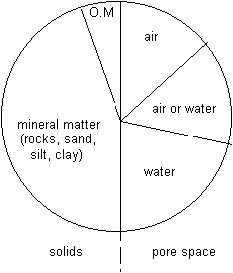Garden with Insight
Product area
Help System
Contents
Quick start
Tutorial
How-to
Models
|
Garden with Insight v1.0 Help: bulk density
Bulk density is the weight of soil solids per unit volume of soil. Soil
solids include mineral solids (clay, silt, and sand) and organic matter. The other constituents of soil
volume are water and pore space.

(Redrawn from Troeh & Thompson 1993)
Units of bulk density are in weight per volume, as in g/cm3 or t/m3. Bulk density can be calculated by
weighing a unit volume of soil, say one cubic meter, with all water
driven out by oven-drying. For example, if you have a cubic meter of soil, and on drying out the soil
(which removes all elements but the soil solids) you find the weight of the soil to be 100 kilograms, then
the bulk density of that soil is 100 kilograms per cubic meter (kg/m3).
In this simulation the bulk density in each soil layer depends on soil
texture (clay/silt/sand content) and organic matter content. It is calculated when the soil patch is created
and changed thereafter by soil aeration with a tool (which decreases it),
soil mixing with a tool (which brings it closer to the settled bulk density), applying an amendment with a
tool (which decreases it if organic matter is added), and settling of the soil during rain (which brings it
closer to the settled bulk density). The settled bulk density is a parameter for the bulk density when the soil is undisturbed by tilling (for a
long time). Bulk density affects the soil temperature in each layer, mineralization of nutrients (greater
bulk density reduces mineralization), soil strength (greater bulk density means more soil strength), the pH change when N fertilizer is added,
and the pH change when lime is applied. Porosity is strongly linked to
bulk density.
How it works:
mixing soil
aerating soil
applying an amendment
soil settling with rain
soil temperature
soil strength
nutrient cycling
auto pH control
increase in acidity due to fertilizer
|

